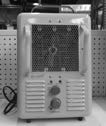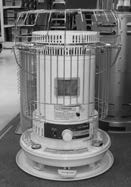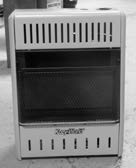Space Heater Safety: Using Kerosene and Propane
EEM-00253 View this publication in PDF form to print or download.
Safety
Safety is a top consideration when using non-electric space heaters. Portable space heaters that use kerosene and propane emit carbon monoxide into the air. In the past decade, Alaska has had the highest rates of carbon monoxide-related deaths in the nation.
Consumers should be aware of the following hazards when buying space heaters that operate on kerosene and propane:
- Fires and burns caused by contact with or close proximity to the flame, heating element or hot surface area.
- Fires and explosions caused by flammable fuels.
- Carbon monoxide poisoning caused by improper venting of fuel-burning equipment.
Before purchasing a portable kerosene- or propane-fueled heater, make sure local building and fire codes permit use in residential structures. Check with your insurance carrier to determine what impact the use of these heaters may have on your homeowners policy. Use only heaters that carry an Underwriters Laboratories (UL) label. This means the product has been tested for safety.
Products manufactured in Europe or purchased in the European market will display a “CE mark.” This marking is equivalent to the UL label — it demonstrates that the product has passed safety requirements according to European directives. Products tested for safety may display a UL label, a CE mark or both.
Convection and Radiant Heaters
Space heaters use two different methods to heat a room: convection or radiant heating. Convection heaters use the circulation of air in a room to warm the area. Radiant heaters emit infrared radiation, which directly heats up objects and people that are within their line of sight. Radiant heaters are a more efficient choice when used in a room for only a few hours.
Vented and Unvented Combustion Heaters

Space heaters fueled by kerosene or propane are also referred to as combustion heaters.
Combustion heaters are classified as vented and unvented, or vent free. Vented units are designed to be permanently located next to an outside wall, so that the flue gas vent can be installed through a ceiling or directly through the wall to the outside.
All portable kerosene- or propane-fueled space heaters are classified as unvented. These units are not recommended for use inside the home due to health hazards associated with the pollutants they emit into the home or unventilated area.

The emitted pollutants include carbon monoxide (CO), nitrogen dioxide (NO2) and other gases. Because these fuels consume oxygen, ventilation must be provided to replace oxygen and to remove gases in order to prevent asphyxiation or respiratory problems.
Health Hazards of Combustion Products

Carbon monoxide is a colorless, odorless gas that interferes with oxygen availability throughout the body. Low levels of CO can cause fatigue and chest pain in people with chronic heart disease. As exposure increases, symptoms progressively worsen, with headaches, drowsiness, nausea, vomiting, confusion and disorientation. At very high exposures, loss of consciousness and death are possible. For more information on this topic, refer to Extension publication Carbon Monoxide: A Silent Killer, RAD-00756.
Nitrogen dioxide, a reddish-brown gas, is an air pollutant that can irritate the skin and the mucous membranes in the eyes, nose and throat. Individuals with asthma, respiratory disorders and lung diseases are especially sensitive to the effects of NO2, but healthy individuals may develop abnormalities when exposed to the gas. Depending upon the level and duration of exposure, respiratory effects range from slight irritation to burning and chest pain, coughing and shortness of breath.
Reducing Exposure to Combustion Products
Take special precautions when operating unvented space heaters. Follow the manufacturer’s directions for using the proper fuel, and provide fresh air. Be sure to check the owner’s manual to ensure that the heater can be used in normal livable space. Some heaters are designated for inside space, but that doesn’t include homes.
Either way, place the portable heater in the center of a well-ventilated room that is equipped with:
- A fire extinguisher
- A smoke alarm with fresh batteries
- A carbon monoxide alarm
Home-Safety Information
For all types of space heaters, follow these specific suggestions:
- Be certain that the space heater is placed on a level, hard and nonflammable surface. Do not place space heaters on rugs or carpets.
- Keep the heaters properly adjusted and clean. Appliances that are not working properly can release harmful, and even fatal, amounts of pollutants.
- Never operate a defective heater. Have all necessary repairs done by qualified repair persons.
Kerosene Space Heaters
- Never use gasoline in a kerosene heater. Even very small quantities of gasoline in the heater tank can cause a fire.
- Never fill the fuel tank of a kerosene heater beyond the full mark because as the fuel warms, it expands and could spill and cause a fire.
- Do not attempt to remove the fuel tank or refuel the heater when it is operating or hot.
- Never attempt to move the heater while it is operating. The heater should have an automatic safety switch to shut it off if it’s tipped over.
- Keep kerosene stored outside in a metal container with a tight-fitting lid that is clearly marked “kerosene.”
Propane Space Heaters
- Propane is a cleaner fuel than kerosene. When burned, it emits ultralow emissions of carbon monoxide. However, unvented propane space heaters still require proper ventilation from outside air.
-
Propane is heavier than air. If a leak occurs, or if you believe a leak has occurred, call the fire department. Do not operate any electrical switches or telephones in the building where the leak has occurred, because a spark could cause an explosion.
Sources
What You Should Know about Space Heaters. U.S. Consumer Product Safety Commission, Washington D.C. February 2001.
A Consumer’s Guide to Energy Efficiency and Renewable Energy. U.S. Department of Energy, Energy Efficiency and Renewable Energy. Retrieved April 25, 2008, from www.eere.energy.gov/consumer/your_home.
Certifying Your Product with CE Marking: https://www.trade.gov/ce-marking.
Comparing Kerosene or Propane to Electricity Costs
The costs of various forms of energy are calculated in several different ways. This can make it difficult for consumers to compare the actual cost of the energy fuels they are using. It may be helpful to compare the cost of kerosene, propane and electricity. What follows is an easy way to calculate costs.
First, some facts:
Btu (British thermal unit) = the standard measure for heat energy
kWh (kilowatt-hour) = the standard unit to measure electrical output
The average Btu content for kerosene, propane and electricity:
|
Kerosene |
135,000 Btu per gallon |
| Propane | 91,800 Btu per gallon |
| Electricity | 3,413 Btu per kWh |
A standard unit for all of these fuels is needed in order to compare them. In this case we will use the amount of fuel required to obtain one million Btu of energy:
|
Kerosene |
7.4 gal/million Btu |
|
Propane |
10.9 gal/million Btu |
| Electricity | 293 kWh/million Btu |
The formula to compare costs is the amount of the energy source (kerosene, propane or electricity) to obtain 1 million Btu, multiplied by the present cost in dollars (cost per million Btu).
Formula: energy source quantity per million Btu x cost in dollars
Example for kerosene*: 7.4 gallons of kerosene x $2.25 (per gallon) = $16.65
Example for propane*: 10.9 gallons of propane x $3.00 (per gallon) = $32.70
Example for electricity*: 293 kilowatt-hours x $0.11 (per kilowatt-hour) = $32.23
Example for electricity at an anticipated rate increase during an electrical crisis in Juneau: 293 kilowatt-hours x $0.33 (per kilowatt-hour) = $096.69 293 kilowatt-hours x $0.54 (per kilowatt-hour) = $158.22
*Prices for the different energy sources vary so make sure to get the current price per gallon or kilowatt-hours.
Portions of this publication were adapted from What You Should Know about Space Heaters by the U.S. Consumer Product Safety Commission.
Art Nash, Extension Energy Specialist. Originally prepared by Sonja Koukel, former Extension Faculty, Health, Home and Family Development.
Revised October 2024
